

Topic 2: Exercise Physiology - IB. Physical Educ8or: IB SEHS: Cardiovascular System Part 1. Physical Educ8or: IB SEHS: Cardiovascular System Part 2. Labelling the heart. Blood Flow through the Heart in 2 MINUTES. How a Healthy Heart Pumps Blood. How the Heart Works 3D Video.flv.
Flow through the Heart. Heart - Cross section. How Does Your Heart Beat. Boundless Anatomy and Physiology. Heart Circulation Coronary circulation is the circulation of blood in the blood vessels of the heart.
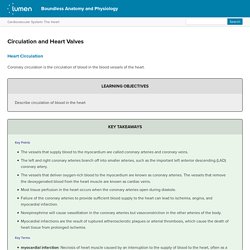
Learning Objectives. 045 The Pacemaker Potential of the SA Node and the AV Node. Cardiovascular System: Control of Heart Rate. 2.2.4 intrinsic & extrinsic control of heart rate. Autonomic nervous system effects on the heart. Electrical System of the Heart. Functions of the Autonomic Nervous System. Sympathetic Responses.
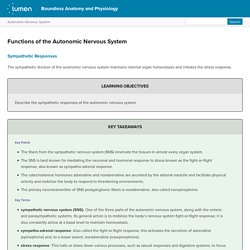
Hormonal and nervous control of heart rate - A2 Science. Blood. These images show erythrocytes (red blood cells), leukocytes (white blood cells) and platelets as they appear in a Wright's stained blood smear.
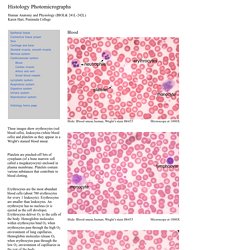
Platelets are pinched-off bits of cytoplasm (of a bone marrow cell called a megakaryocyte) enclosed in plasma membrane. Platelets contain various substances that contribute to blood clotting. Erythrocytes are the most abundant blood cells (about 700 erythrocytes for every 1 leukocyte). Erythrocytes are smaller than leukocytes. Circulatory system physiology. Regulation of blood pressure with baroreceptors. Valsalva Maneuver. Cardiac Output, Stroke volume, EDV, ESV, Ejection Fraction. Cardiovascular System Physiology - Cardiac Output (stroke volume, heart rate, preload and afterload) Cardiovascular System6. Heart Function 3; Contro of HR and cardiovascular drift.
Blood Pressure Response to Exercise. Venous return, Starling's law & cv drift. 046 How Adrenaline and Acetylcholine Affect Heart Rate. Cardiac Conduction System and Understanding ECG, Animation. Circulatory Pulmonary & Systemic Circulation. The Effect Of Cardiac Drift On Heart-Rate Training – Competitor Running. In this graph demonstrating cardiac drift, pace remains relatively constant (blue) while the heart rate (red) continually increases.
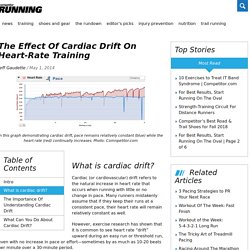
Photo: Comnpetitor.com Cardiac (or cardiovascular) drift refers to the natural increase in heart rate that occurs when running with little or no change in pace. Many runners mistakenly assume that if they keep their runs at a consistent pace, their heart rate will remain relatively constant as well. However, exercise research has shown that it is common to see heart rate “drift” upward during an easy run or threshold run, even with no increase in pace or effort—sometimes by as much as 10-20 beats per minute over a 30-minute period. The photo above is an illustration of how cardiac drift looks during a 20-mile long run. It is important to emphasize that cardiovascular drift results in an increased heart rate without a corresponding rise in effort, breathing rate, or calories burned.
B3.3 Compare the distribution of blood flow at rest and during exercise. 2.2.12 redistribution of blood flow. 231. Queens College Step Test. Testing and measurement are the means of collecting information upon which subsequent performance evaluations and decisions are made but, in the analysis, we need to bear in mind the factors that may influence the results.
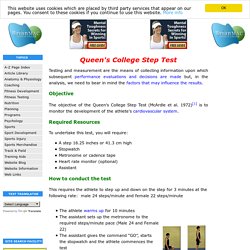
Objective The objective of the Queen's College Step Test (McArdle et al. 1972)[1] is to monitor the development of the athlete's cardiovascular system. Required Resources To undertake this test, you will require: A step 16.25 inches or 41.3 cm high Stopwatch Metronome or cadence tape Heart rate monitor (optional) Assistant. Harvard Step Test. Testing and measurement are the means of collecting information upon which subsequent performance evaluations and decisions are made.

In the analysis, we need to bear in mind the factors that may influence the results. The Harvard Step Test was developed by Brouha et al. (1943)[2] Objective. Pulse Oximetry: Uses, Readings, and How It Works. Pulse oximetry is a noninvasive and painless test that measures your oxygen saturation level, or the oxygen levels in your blood.
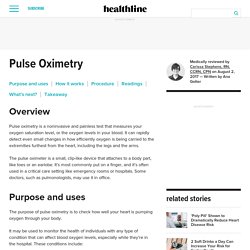
It can rapidly detect even small changes in how efficiently oxygen is being carried to the extremities furthest from the heart, including the legs and the arms. The pulse oximeter is a small, clip-like device that attaches to a body part, like toes or an earlobe. It’s most commonly put on a finger, and it’s often used in a critical care setting like emergency rooms or hospitals. Some doctors, such as pulmonologists, may use it in office. How Eliud Kipchoge Ran a Sub 2 Hour Marathon. How Exercise Improves Heart Health – Healthfirst Healthy Living.
Quadriceps femoris muscle. Why & How To Work Out Your VO2 Max. Sheep's Heart Dissection. Differences Between Sympathetic And Parasympathetic Nervous System. The Autonomic Nervous System The autonomic nervous system controls specific body processes, such as circulation of blood, digestion, breathing, urination, heartbeat, etc.

The autonomic nervous system is named so, because it works autonomously, i.e., without a person’s conscious effort. The primary function of the autonomic nervous system is homeostasis. Apart from maintaining the body’s internal environment, it is also involved in controlling and maintaining the following life processes: DigestionMetabolismUrinationDefecationBlood pressureSexual responseBody temperatureHeartbeatBreathing rateFluid balance. Cardiac Anesthesiology: Preload, Control of Blood Pressure, Cardiac Physiology, Starling’s Law. 048 How to Read an Electrocardiogram (ECG/EKG) Who ps pulse oxymetry tutorial1 the basics en.